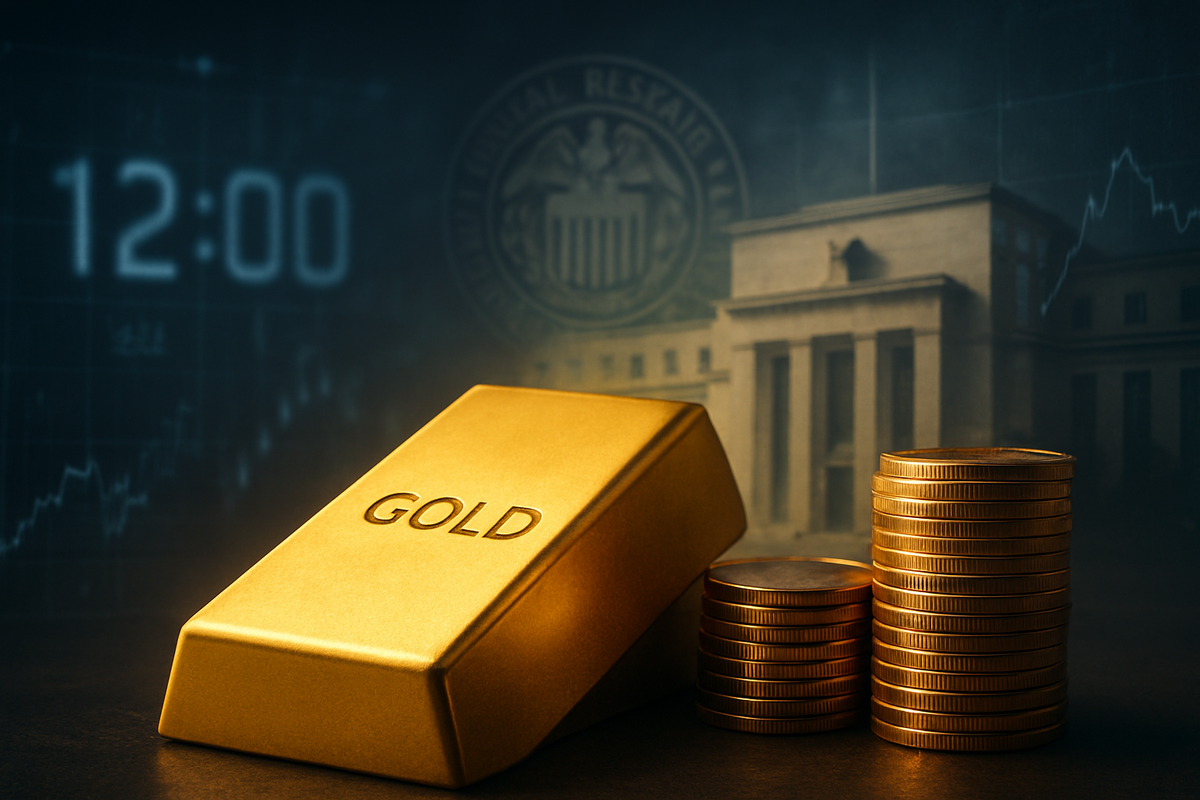
New York, NY – November 11, 2025 – The financial markets are abuzz with the anticipation of further US interest rate cuts, a sentiment that has propelled gold prices to unprecedented highs. This bullish momentum for the yellow metal is largely influenced by a confluence of factors, including signs of a softening US economy, a recent government shutdown delaying crucial economic data, and the Federal Reserve's cautious but clear pivot towards monetary easing. As of today, investors are keenly watching the Fed's next moves, with many betting on a December rate cut, which promises to reshape investment strategies and impact a wide array of public companies.
The immediate implication of this environment is a reduced opportunity cost for holding non-yielding assets like gold. With interest rates expected to trend downwards, the appeal of traditional interest-bearing investments diminishes, making gold a more attractive safe haven. This dynamic, coupled with persistent global uncertainties, has sent gold surging, marking an extraordinary year for the precious metal and signaling a significant shift in market sentiment.
The Fed's Delicate Dance: Data Delays and Dovish Signals
The Federal Reserve finds itself in a challenging position, likened by Chair Jerome Powell to "driving in the fog," primarily due to the ongoing US government shutdown that has delayed the release of critical economic data. Key reports, including the national jobs report for October and comprehensive inflation data, which are usually vital for the Fed's monetary policy decisions, are currently unavailable. This data vacuum complicates the Fed's ability to accurately assess the economy's health.
Despite these data gaps, a narrative of economic weakness has emerged from preliminary indicators. October saw job losses, particularly in government and retail sectors, while consumer sentiment in early November experienced a sharp decline, reflecting growing financial concerns among households. These signals have intensified market expectations for further monetary easing.
The Fed has already initiated an easing cycle with two 25-basis-point (bps) rate cuts in September and October 2025, bringing the federal funds rate to a target range of 3.75%-4.00%. Market probabilities for a December 2025 cut currently range from 60% to 70%. While some Fed policymakers, like Governor Stephen Miran, have even suggested a more aggressive 50 bps cut, Chair Powell has maintained that a December cut is "not a foregone conclusion," emphasizing the need for more clear economic data once the shutdown ends. Firms like Goldman Sachs Research, however, still forecast a December cut, followed by two more 25-basis-point reductions in March and June 2026.
Key players involved in this unfolding scenario include the Federal Reserve's Federal Open Market Committee (FOMC), market analysts from institutions like Goldman Sachs and JPMorgan, and gold traders and investors who are actively responding to interest rate expectations. The initial market reaction in the gold sector has been overwhelmingly bullish, with prices surging to multi-week highs and some analysts predicting it could test resistance levels around $4160 in the very short term, with forecasts of $4,500 to $4,700 per ounce by the end of 2026, and even surpassing $5,000 per ounce.
Winners and Losers: Corporate Fortunes in a Shifting Landscape
The anticipated trajectory of US interest rate cuts and the sustained rally in gold prices create a distinct set of winners and losers across various public companies.
Gold Mining Companies (Potential Winners): The sustained high gold prices are a boon for gold mining companies, directly boosting their revenues and profit margins.
- Newmont Corporation (NYSE: NEM): As one of the world's largest gold producers, Newmont's profitability is highly sensitive to gold prices. High prices directly enhance its earnings and cash flow.
- Barrick Gold Corporation (NYSE: GOLD): Another major global gold miner, Barrick Gold directly benefits from strong gold prices, improving its operational leverage.
- AngloGold Ashanti plc (NYSE: AU): This South African-based producer sees increased revenues and potential for shareholder returns with elevated gold prices.
- Kinross Gold Corporation (NYSE: KGC): Kinross has been a standout performer in 2025, with its shares significantly benefiting from the surge in gold prices.
- McEwen Mining Inc. (NYSE: MUX): A smaller gold and silver producer, McEwen Mining would also see substantial benefits from high gold prices.
- Hecla Mining Company (NYSE: HL): Primarily a silver producer with significant gold assets, Hecla benefits from strong precious metal prices.
Financial Institutions (Mixed Impact, Potential Winners from Delayed Cuts): While a full-blown easing cycle can narrow net interest margins for banks, a slower-than-anticipated pace of cuts or a "higher for longer" scenario (even if temporary) can support wider margins, benefiting banks.
- JPMorgan Chase & Co. (NYSE: JPM): As the largest U.S. bank, JPMorgan can see its net interest margin expand if rates remain elevated for longer than expected.
- Bank of America Corporation (NYSE: BAC): Known for its asset sensitivity, Bank of America's earnings are particularly responsive to sustained high interest rates.
- Charles Schwab Corporation (NYSE: SCHW): This brokerage firm profits from investing client cash balances, and higher rates allow it to capture a larger spread.
Interest-Rate-Sensitive Sectors (Potential Losers from Delayed Cuts): Sectors heavily reliant on borrowing or consumer financing costs face headwinds if interest rates remain elevated or cuts are delayed.
- Real Estate (e.g., Homebuilders, REITs): Higher mortgage rates, a consequence of elevated interest rates, can cool housing demand and increase borrowing costs for developers. For example, D.R. Horton, Inc. (NYSE: DHI), a major homebuilder, would face reduced demand and higher financing costs. Similarly, REITs like EPR Properties (NYSE: EPR), which rely on capital for acquisitions, would find expansion more expensive.
- Utilities: Capital-intensive utility companies, represented by ETFs like the Utilities Select Sector SPDR Fund (NYSEARCA: XLU), require substantial borrowing for infrastructure. Delayed rate cuts mean higher borrowing costs, impacting profitability.
Wider Significance: A Global Rebalancing Act
The Federal Reserve's policy trajectory, characterized by an active easing cycle following earlier rate hikes, has profound wider significance for commodities, financial markets, and the global economy. This shift comes after a period where the "higher for longer" stance initially kept the dollar strong and created headwinds for many global economies.
This event fits into broader industry trends for commodities, where precious metals beyond gold, such as silver, platinum, and palladium, have also seen significant gains. This general uplift is often tied to a weaker dollar and heightened safe-haven demand. In equities, while high-growth tech firms were previously vulnerable, easing can provide some relief, though market impacts remain uneven. The bond market, which saw long-term yields approach 5% earlier in 2025, is now expected to see moderate declines as expectations for lower short-term rates take hold.
The ripple effects extend globally. Other central banks, such as the Bank of England (expected to cut rates in December 2025), are navigating their own economic landscapes, often influenced by the Fed's actions. For emerging markets, lower US interest rates traditionally encourage capital inflows, offering relief to developing economies by reducing borrowing costs for dollar-denominated debt. However, the preceding "higher for longer" period created significant challenges. Globally, growth is projected at 3.0% for 2025 and 3.1% in 2026, but trade policy uncertainty and tariffs, particularly from the US, continue to pose downside risks and complicate global trade patterns.
Historically, gold has shown a strong inverse relationship with real (inflation-adjusted) federal funds rates, performing strongly during periods of low or negative real rates (e.g., 1970s, post-2002). Gold also tends to rally significantly in the 24 months following the Fed's first interest rate cuts, as seen after the November 2000, June 2007, and June 2019 cuts, which were typically in response to economic slowdowns or crises. These precedents underscore gold's role as a safe haven during periods of economic uncertainty and monetary easing. Regulatory implications include the ongoing focus on tariffs contributing to inflation, the impact of the government shutdown on data availability, and questions about fiscal credibility influencing bond yields.
What Comes Next: Navigating the Path Ahead
The coming months and years promise a dynamic environment for US interest rates and gold prices, requiring strategic pivots from investors and businesses.
In the short-term (Q4 2025 - H1 2026), market expectations for further Fed rate cuts remain high. Goldman Sachs projects another cut in December, followed by two more in March and June 2026. This gradual easing is expected to continue supporting gold's upward momentum, with analysts projecting gold to average around $4,000/oz in Q4 2025 and potentially reach $4,100/oz in Q1 2026.
Long-term (2026-2027 and beyond), the consensus points to a continued easing path, with the federal funds rate potentially reaching 3.0%-3.25% by mid-2026, and potentially lower if economic growth slows significantly. Major financial institutions like JPMorgan Chase & Co. (NYSE: JPM) and Bank of America (NYSE: BAC) have revised their gold forecasts upwards, projecting prices to reach $4,000-$5,000+ by 2026. This bullish outlook is driven by lower opportunity costs, a weakening US dollar, persistent safe-haven demand, and continued central bank accumulation.
Strategic pivots for investors include re-allocating towards assets that thrive in a lower interest rate environment and a potentially weaker dollar, such as equities and alternative assets like gold. Diversifying portfolios with gold is considered a prudent strategy against geopolitical and economic uncertainties. For businesses, lower interest rates translate to reduced borrowing costs, potentially stimulating investment and deal activity. However, they must also adjust to falling yields on savings and money market funds and manage currency volatility.
Emerging markets present significant opportunities, as lower US rates can lead to capital inflows and a weaker dollar eases the burden of dollar-denominated debt. Countries like India, Brazil, and Vietnam are highlighted as top investment destinations. However, challenges remain, including currency volatility, political risks, and potential disruptions from trade protectionism.
Various scenarios could unfold: a base case of gradual rate cuts and a "soft landing" for the economy would see gold continue its bullish trajectory. A "higher for longer" scenario, driven by stubborn inflation, could temper gold's momentum but still support it as an inflation hedge. A stagflation/recession scenario would be very bullish for gold, as it thrives during periods of economic uncertainty. Conversely, a stronger-than-expected economic recovery might dampen gold's safe-haven appeal.
Wrap-up: A Golden Horizon in Uncertain Times
The current financial climate, as of November 2025, is defined by the Federal Reserve's decisive shift towards monetary easing and gold's extraordinary performance as a beneficiary. The anticipation of further US interest rate cuts, driven by signs of economic cooling and complicated by delayed economic data, has fundamentally altered market dynamics.
Key takeaways include the Fed's active easing cycle, the high probability of further rate cuts, and gold's impressive rally, fueled by reduced opportunity costs, a weaker US dollar, and robust safe-haven demand from both investors and central banks. The market's likely trajectory points towards continued rate reductions into 2026 and 2027, underpinning an overwhelmingly bullish outlook for gold prices, with many major institutions forecasting prices well above current levels.
The lasting impact of this period will likely be a rebalancing of global reserves away from the US dollar towards gold, driven by de-dollarization trends and geopolitical uncertainties. Persistent inflationary pressures and fiscal concerns will also maintain gold's appeal as an inflation hedge. The current environment also highlights increased volatility and policy risks, underscoring the importance of central bank independence and data transparency.
For investors in the coming months, vigilance is paramount.
- Monitor Fed signals and economic data closely: Any deviation from the anticipated easing path or unexpected economic data could introduce significant volatility.
- Embrace gold as a portfolio hedge: Its role as a diversifier against economic uncertainty, geopolitical risks, and a potentially weaker dollar remains strong.
- Consider buying dips: With a bullish long-term outlook, short-term price corrections in gold could present buying opportunities.
- Diversify gold investments: Explore physical bullion, gold-backed ETFs, and mining stocks to manage risk and optimize exposure.
- Maintain patience and robust risk management: The market will likely experience temporary fluctuations, but the fundamental drivers for gold remain strong.
- Watch the global economic landscape: Central bank purchasing patterns, international trade policies, and geopolitical events will continue to influence gold prices.
This content is intended for informational purposes only and is not financial advice





